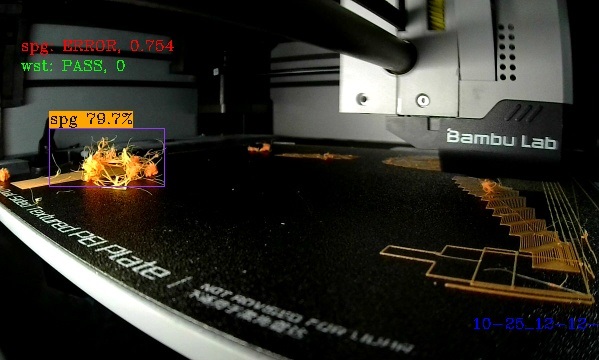¶ Spaghetti Detection
In the X1C, we have a USB camera installed in the corner of the printer chamber. X1's Chamber Camera is optional, you can get it from our store. (Install guide: Chamber Camera Replacement Guide) With this Chamber Camera, we can do a lot of wonderful things, e.g. live video stream, timelapse, and most importantly, real-time monitoring of the printing process. Spaghetti Detection, among all the others, is the one of excellent features of printing monitoring.
By the word spaghetti, we mean a broad range of printing failures, most of which are just like the famous Italian food spaghetti. However, there are also cases where the filament fragments are not so typically spaghetti-ish, but scattered in small pieces. In our Spaghetti Detection, all these failures are considered the same kind.



¶ How it works
Thanks to the powerful on-chip NPU, we can achieve onboard Spaghetti Detection just inside the printer. Here is the brief procedure:
Take a frame of the Chamber Camera every T sec.
Feed the image to the AI detector running on the NPU. The detector is a state-of-the-art object detection neural network, which finds the bounding box of the potential spaghetti with a confidence value. If the confidence is high enough (the confidence threshold is determined by the sensitivity you choose), it is considered a positive candidate.
Postprocess the detection results. We accumulate the results for the latest 10 frames. If there are enough positive candidates, and they are spatially consistent, then a spaghetti failure is detected.
To have the detector work properly, there are a few requirements.
- The detector needs to be enabled in the Print Options. You can adjust the sensitivity from {low, medium, high}. If you are off the printer for a relatively long time (e.g. a whole night), you can set the sensitivity to low, so it's less often to pause the printing for small defects.
- The chamber light needs to be on. The spaghetti detector needs a good lighting condition to capture the details of prints. By default, we switch on the light when the first layer starts to print. If the light is shut down manually, it will not be turned on again.
In the "LAN Only" mode, the Spaghetti Detection function is still functioning. Know more about the LAN Only mode from How to enable LAN Mode on X1 / P1 series printers.
The X1 series can detect failures/spaghetti based on the processing power it has. This system uses a machine-learning algorithm and all the data processing is done locally.
When the printer is used in LAN mode, the printer behaves just like when it is not connected to the internet and uses local processing to provide this feature.
If the printer is not connected to the cloud, and the user improvement option is not enabled, the printer will rely only on the information it has in the latest firmware for failure detection, which might be outdated compared to the cloud-connected experience where the AI model is updated regularly. We recommend updating the firmware regularly to benefit from additional improvements that will be added over time.
¶ How to help
Same as all the deep learning functions, we highly rely on data. If you have been using this function from the very beginning, you'll notice that we have gained a huge jump in detection accuracy, but still not high enough. There are always false alarms reported from time to time. We need your help to improve this function, and it's really simple: join the experience improvement program. The image data will be automatically uploaded to the cloud if you join the program.